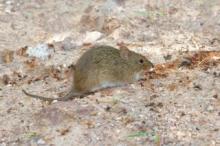Q: How do I tell the difference between wood rats (pack rats) and roof rats and does it matter?

A:
Chandler, Arizona
There are many types of rats in Arizona, and in certain areas, you can find both types of rodents - Arizona definitely has both. The easiest way to differentiate between roof rats and wood rats is to look at the tail. Roof rats have a hairless tail and wood rats have a shorter but bushy tail (like a pipe cleaner). It is important to make that identification before any management program is started. Remember that some rodent species are considered threatened or endangered and this can include wood rats. Once you know which type of rat you are dealing with, you can set up a management program that may or may not include the use of rodenticides. There are many species of rats and not all species are listed on commonly used commercial rodenticides. There are many species of rats and not all species are listed on commonly used commercial rodenticides. Here is a possible list of potential list but the “The most commonly encountered rats in Chandler are roof rats and white-throated wood rats*.”
Types Of Rats In Arizona
Below are some common rat species found in Arizona. Some Arizona rats include:
- Roof rat (Rattus rattus, from the family Muridae), also known as ship rat, black rat, or house rat
- Norway rat (Rattus norvegicus, from the family Muridae), also known as common rat, street rat, sewer rat, Hanover rat, Norway rat, Norwegian rat, Parisian rat, or wharf rat
- Bushy-tailed wood rat (Neotoma cinerea, from the family Cricetidae), also known as packrat
- White-throated wood rat (Neotoma albigula, from the family Cricetidae)
- Desert wood rat (Neotoma lepida, from the family Cricetidae), a species of pack rat
- Mexican wood rat (Neotoma mexicana, from the family Cricetidae)
- Stephen’s wood rat (Neotoma Stephensi, from the family Cricetidae)
*Information provided by Dr. Dawn Gouge, Public Health Entomologist. University of Arizona and Dr. Niamh Quinn. University of California Cooperative Extension










